
Ipomopsis arizonica is a flowering plant in the family Polemoniaceae, native to the mountains of the Mojave Desert sky islands from southeastern California east through southern Nevada to northern Arizona, growing at 1500–3100 meters in elevation. It is found in rocky places in the desert, as well as washes.

Collomia linearis is a species of flowering plant in the phlox family known by the common names tiny trumpet and slenderleaf collomia. This tiny wildflower is native to North America where it is fairly widespread across the north and west. It is an annual herb, rarely exceeding 30 centimetres (12 in) in height, with a velvety erect stem bearing long, narrow green leaves. Atop the stem is a cluster of up to 20 white or light pink flowers, each about a centimeter across. Each has five small rounded petals and stamens tipped with anthers bearing white pollen.
Downingia insignis is a species of flowering plant in the bellflower family known by the common names harlequin calicoflower and cupped downingia. This showy wildflower is native to the western United States from California to Idaho, where it is a resident of lakesides and vernal pool ecosystems.

Downingia pulchella is a species of flowering plant in the bellflower family known by the common names flatface calicoflower and valley calicoflower. This showy, annual wildflower is endemic to California, where it is a resident of vernal pools and other wet places in the central part of the state from the Tehachapi Mountains to the San Francisco Bay Area.
Gilia minor is a species of flowering plant in the phlox family known by the common name little gilia. It is native to the Mojave Desert and it is also present in the coastal Santa Lucia Mountains of central-southern coastal California.
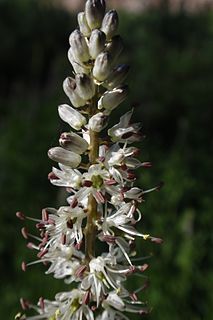
Hastingsia alba is a species of flowering plant known by the common names white rushlily and white schoenolirion.

Hydrophyllum occidentale is a species of flowering plant in the waterleaf family known by the common name western waterleaf.

Ipomopsis congesta is a species of flowering plant in the phlox family, known by the common name ballhead ipomopsis. It is native to much of western North America, where it grows in many habitats from alpine peaks to low-elevation scrub. It is a perennial herb which varies in appearance, especially across subspecies and climates. It may take the form of a squat patch with stems under 10 centimeters in height or a more erect form up to 30 centimeters tall. The stems are often hairy to woolly. The thick leaves are usually fork-shaped with a number of clawlike lobes and 1 to 4 centimeters long. The flowers appear in a rounded, dense cluster atop the stem. Each flower is bell-shaped to funnel-shaped and white with a pale yellow throat and protruding yellow or white stamens. There are several subspecies, many of which were formerly considered species of Gilia.
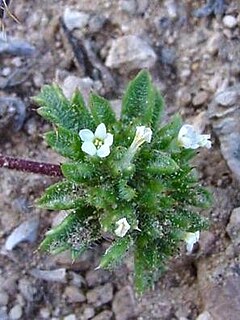
Ipomopsis polycladon is a species of flowering plant in the phlox family known by the common name manybranched ipomopsis. It is native to much of the western United States and northern Mexico, where it grows in sandy soils such as those of the deserts. This is an annual herb producing a number of horizontal red stems extending outward from the short central stem. Leaves appear at the ends and axils of branches. Each leaf is multilobed, and mostly green but often red-tipped, and less than 2 centimeters long. Stems and leaves are covered with woolly glandular hairs. The long stem branches bear inflorescences of leaflike bracts which are green with sharp-pointed red tips, and tiny white flowers a few millimeters across.
Ipomopsis tenuituba is a species of flowering plant in the phlox family known by the common name slendertube skyrocket, or slendertube ipomopsis. It is native to much of the western United States from California to Colorado, where it is found on rocky mountain slopes. This is a perennial herb producing an erect stem with widely spaced leaves, each 3 to 6 centimeters long and with many narrow, fingerlike lobes. The inflorescences toward the top of the stem each hold three to seven flowers. The flower is very pale to medium pink, sometimes with white streaks, or solid white. It is a tube 2 to 5 centimeters long, opening into a corolla of five twisting, pointed, ribbonlike lobes. The stamens and style do not protrude far from the mouth of the flower, if at all. While it is a perennial plant, it dies after its first flowering.

Enemion occidentale is a species of flowering plant in the buttercup family known by the common name western false rue anemone. It is endemic to California where it is a resident of forest, woodland, and chaparral habitats in many of the mountain ranges. This is a small perennial herb producing one or more erect, unbranched stems growing to maximum heights near 25 centimeters. Leaves appear toward the top of the smooth, naked stems. Each green cloverlike leaf is divided into usually three irregular lobes. The solitary flowers are petite with white to very light lavender petallike sepals and no petals. At the center are white stamens with yellow anthers and white styles with yellow stigmas.

Saltugilia splendens, is a species of flowering plant in the phlox family known by the common names splendid woodland-gilia, Grinnell's gilia and splendid gilia.

Mesembryanthemum nodiflorum is a species of succulent plant in the genus Mesembryanthemum known by the common name slenderleaf iceplant. It is the type species for the genus. It is native to coastal areas of the Mediterranean Basin, Macaronesia, and Middle East but it is known in many other places as an introduced species and sometimes an invasive weed, including several regions of Australia, parts of the western United States and adjacent Mexico, and some Atlantic islands.
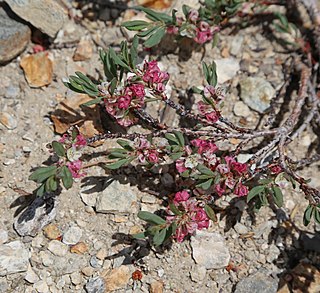
Polygonum shastense is a species of flowering plant in the knotweed family known by the common name Shasta knotweed. It is native to sections of southwestern Oregon, northwestern Nevada, and northern and central California, where it grows in rocky and gravelly mountainous habitat up to 3300 meters (11,000 feet) elevation. It is most common in the Sierra Nevada. The species name refers to its occurrence on Mount Shasta in Shasta County, California.
Ribes binominatum is a species of currant known by the common names trailing gooseberry and ground gooseberry.

Silene bernardina is a species of flowering plant in the family Caryophyllaceae known by the common name Palmer's catchfly.
Saltugilia latimeri is an uncommon species of flowering plant in the phlox family known by the common name Latimer's woodland gilia. It is endemic to California, where it is known from several scattered occurrences in the western Mojave Desert and outlying areas to the north. It occurs in dry rocky and sandy desert canyons. It was first described as a species in 2001.
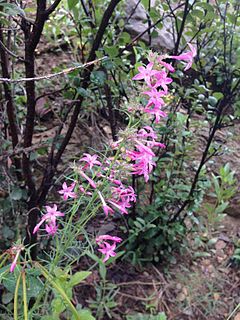
Ipomopsis sancti-spiritus is a rare species of flowering plant in the phlox family known by the common name Holy Ghost ipomopsis. It is endemic to New Mexico in the United States, where it is known from only one canyon in the Sangre de Cristo Mountains. It is a federally listed endangered species.
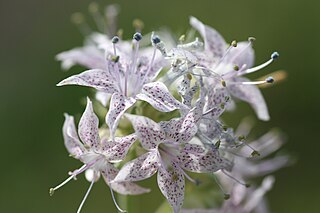
Ipomopsis polyantha is a rare species of flowering plant in the phlox family known by the common names Pagosa ipomopsis, Pagosa skyrocket and Archuleta County standing-cypress. It is endemic to Colorado in the United States, where it occurs only in the vicinity of Pagosa Springs in Archuleta County. It is threatened by the loss of its habitat to residential and commercial development. It was federally listed as an endangered species in 2011.














